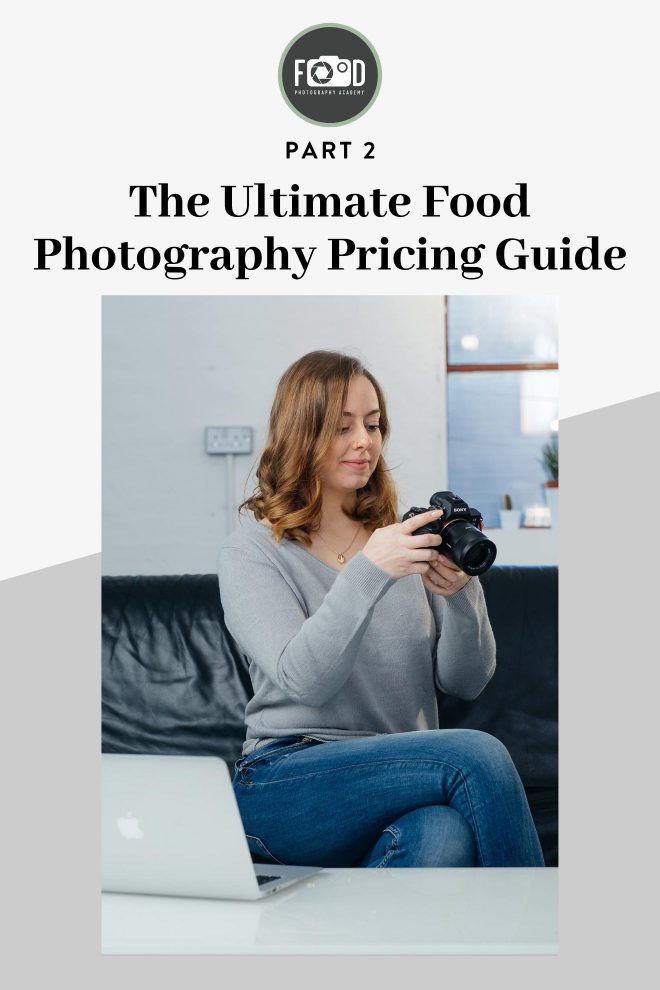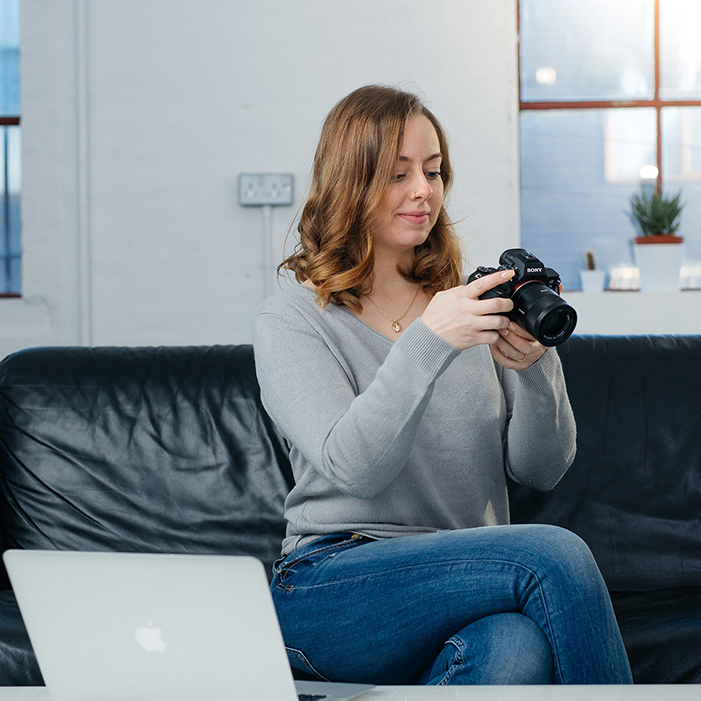Part 2: Pricing for different types of clients
If you haven’t read Part One of our Food Photography Pricing Guide, you can check it out here.
Once you’ve looked through your finances and have gotten a general idea of how much money you want to make per month from your food photography business, you can really start looking into how you want to price your services.

As we talked about previously, there are several different client types when it comes to food photography. Each type has differing requirements and budgets that affect how you should price your services for each specific shoot/client. This post in our food photography pricing guide covers all of these different types of clients and how to price your services for each one.
Your Pricing Structure
Your pricing for any job is made up of three parts:
Part 1: The Creative Fee – This is the fee that covers your time as a photographer, from start to finish on a job. You should calculate how much time this job will take you (not just the actual shooting/processing time) and factor that into your creative fee.
Part 2: Shoot Expenses – Anything extra you need for a shoot, i.e. food stylist, assistants, equipment rental, food expenses, etc. – the list goes on! Make sure you know the costs for these before you start. For more insight on how to factor these often hidden costs into your business model, check out my Business Blueprint Guide!
Business Blueprint Guide:
Part 3: Usage License – Depending on the intended use of the images you create, the license fee you charge a client will vary widely. If you’re in the UK, you can use this calculator to help you determine how much to charge.
Always keep these in mind as you read the rest of this food photography pricing guide.
How to Price Different Kinds of Food Photography Jobs
Along with these two client types we discussed in the earlier part of our food photography pricing guide, there are different kinds of photoshoots and jobs you may be hired for. For example, it’s easy to see how photos for a magazine are very different from photos for a product advertisement or cookbook.
Each photoshoot/project type has specific requirements and formats. So, rather than sticking to one specific way of pricing all these different kinds of shoots, it’s helpful to adjust your pricing method depending on what kind of job it is.
There are several different ways you can price your photography services: per hour, per day (or half-day), per shot, per recipe, or a package rate. However, one point still applies no matter what type of shoot it is or whatever pricing method you choose: you’ll want to price your shoot based on client size. If it’s a bigger company or agency, price your services higher!
Here are the main types of food photography jobs out there and how I recommend you price them…
Editorial
Editorial photography is for magazines and storytelling work predominantly. The magazine or company will often have a photography budget for the project that they will present to you. This means that it is often easier to charge by the concept or project instead of a day rate.
You’ll often work with a stylist for this kind of work, and will probably hire them yourself, so this is something you need to factor into your pricing.
Magazines are likely to pay more for a large, featured image versus a filler. (Meaning the larger the image will be in print, the more you can charge for it.) If you’re only photographing the featured shot, you may want to charge per shot.
Commercial
Commercial jobs are where you work with a client to create images for their commercial use (but not advertising – more on that below).
You often have to hire your own assistants, bring all your own gear, rentals, maybe even stylists and props, and everything else you need. So, these shoots have more expenses and your pricing needs to reflect that.
To price these jobs, you need to figure out the 3 different parts of your fee that we discussed earlier in this food photography pricing guide: your creative fee (your photographer’s fee for creating the image), any shoot expenses (as listed above), and a usage license for the images.
For the usage license: consider how these photos will be used and include a licensing/usage fee in your rate. For example, if you’re photographing an image for a product package that will be distributed internationally, this is going to make a company far more money than a small image for a local restaurant menu, so your license should reflect that.
However, if you’re working with a smaller company or restaurant, such as a new, local cafe, it may be more beneficial to charge a package rate since their budget will likely be limited. Your package can be for something like 10 shots or photos of 10 dishes on their menu. Whatever you think is fair and fitting!
Advertising
Food photography for advertisements has similar considerations to other forms of commercial food photography. However, these kinds of shoots can be more complex and demanding, since they often require highly branded images. Plus, if you’re working on an ad campaign, you’re probably working with an agency (aka: a client with a bigger budget).
The license fee for these kinds of photos can be significantly higher than regular commercial work, so make sure you’re familiar with that and price appropriately.
When it comes to a food photography pricing guide, I typically recommend pricing your services per day for these kinds of shoots, but if the images the client wants are very complex, you may want to price per shot.
Publishing/Cookbook
Since cookbooks are large-scale projects that will take several days or weeks to complete, it’s often easiest to price for the entire project.
Cookbooks are a big undertaking, so don’t be tempted to undercharge for these. Big shoots could take your full time for a month or so, so compare what you could be making working on other client work, and make sure that the project is worth your time financially.
You’ll likely be working with a full crew (at least a stylist and assistant) and will accumulate expenses yourself. Be sure to factor this into your pricing quote!
Photos for web
Shooting for the web can be a tricky one to fit into a food photography pricing guide, because of the wide range of kinds of clients and jobs out there in this category. From food blogs to social media content, to other digital marketing needs…who knows what kinds of requests you’ll see!
Photos intended for web usage often don’t pay as well as other forms of food photography. However, these jobs are often more simple to complete than other kinds of projects. It may be a good supplemental job for you to take on.
Since these jobs tend to be lower-budget, it’s often best to price them per overall package/concept or by the number of shots. Your main goal is to make sure your own expenses are covered, and you make the profit you want for your time. If you take anything from this food photography pricing guide, remember: don’t take on jobs that aren’t actually worth it or aren’t truly making you money!
If you’re looking for more guidance about how to build a sustainable business, the food photography pricing guide is only the beginning. My Business Blueprint Guide gives you step-by-step wisdom on how to set yourself up for success as a food photographer!
Business Blueprint Guide:
Consider your niche
The next step in this food photography pricing guide for you to consider as you work on pinpointing your own pricing guidelines is to keep in mind what (and who) your specific niche is in the food photography industry.
For example, do you think you’ll work more with direct clients or agencies? What kinds of jobs/shoots do you plan to (or already) work on the most? Where are you hoping to expand or move as you grow your business?
Make sure your pricing reflects these factors! Of course, this doesn’t mean your pricing is set in stone or that you can’t take on other kinds of jobs. This information will simply help guide you as you get a general idea of how to price your services.
Remember the golden rule: price based on client size
At the end of the day, no matter what kind of job or client you’re working for, there’s one golden rule of food photography pricing…Price your services based on the size of the client you’re working with!
I don’t recommend doing this in your creative fee – this is the part that covers your time, skill level, and business costs, so whatever the size of the client, this rarely changes.
Instead, the big adjustment comes with the license cost. There’s no hard and fast rule for how to price licenses, but I typically scale my license cost based on the size of the client I’m working with. This makes sense as larger companies will typically have a wider reach than a small, local restaurant, so it makes sense to adjust this part of the pricing instead of your creative fee.
Don’t forget to sign up for my FREE Business Blueprint Guide for more tips to take your food photography business to the next level.
Business Blueprint Guide:

I think your blog helps me a lot. You nicely describe this food photography pricing guide.